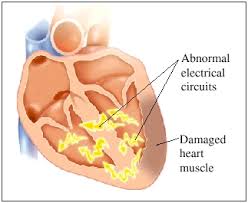arrhythmia
英 [əˈrɪð.mi.ə]
美 [əˈrɪð.mi.ə]
- n. 心律不齐,[内科] 心律失常

记忆方法
将“arrhythmia”拆分为“ar-ryth-mia”。首先,“ar”在英语中常表示不、无或加强的意义,这里可以理解为不规则的。接着,“ryth-”是“ rhythm”的缩写,代表节奏。最后,“-mia”是医学名词后缀,常用来表示状态或情况。因此,记忆方法为:不规则的心跳节奏状态。这样可以帮助你记住“arrhythmia”这个医学名词的含义。
以上内容由AI生成, 仅供参考和借鉴
权威例句
- 1. Sinus arrhythmia also tends to disappear with advancing age.
- 随着年龄的增长,窦性心律不齐也趋于消失.
- 2. Palpitation from frequent extrasystoles or other arrhythmia is common.
- 来自频发的期前搏动或其他心律不齐的心悸亦属常见.
- 3. This normal variation in rhythm is known as sinus arrhythmia.
- 节律的这种正常变化称为窦性心律失常.
- 4. The heart frequently exhibits ventricular arrhythmia.
- 心脏经常表现出室性心律不齐.
- 5. [ Burke ] There's an arrhythmia when I press down on the tumor.
- 病人心律失常当我压迫肿瘤的时候.